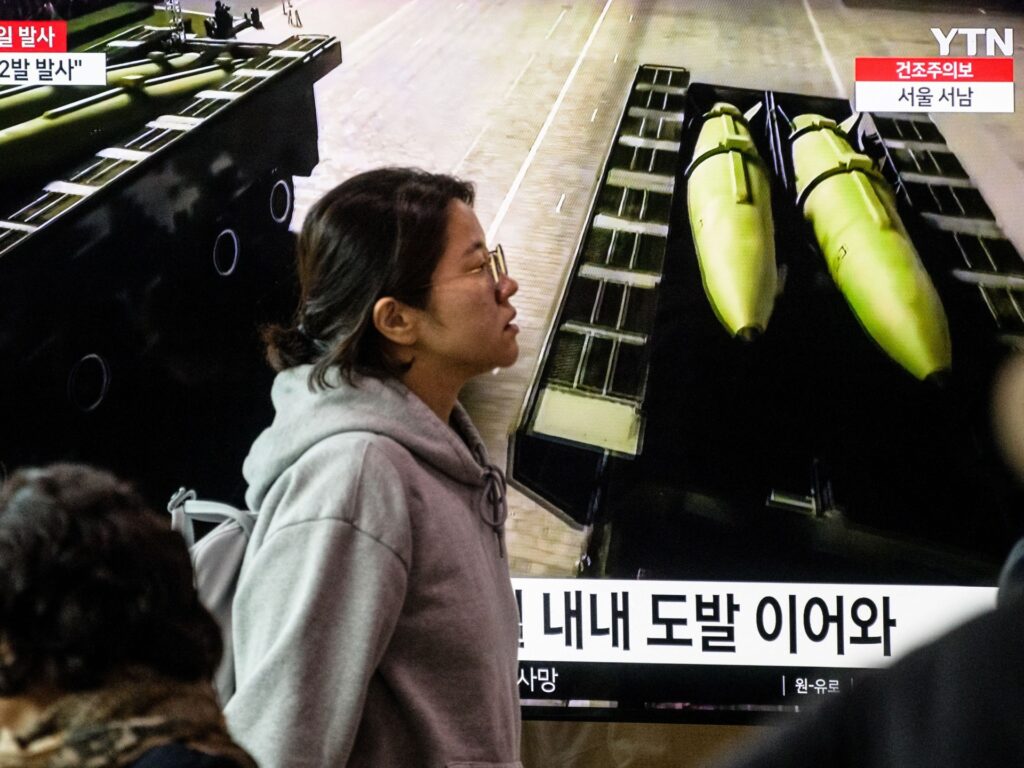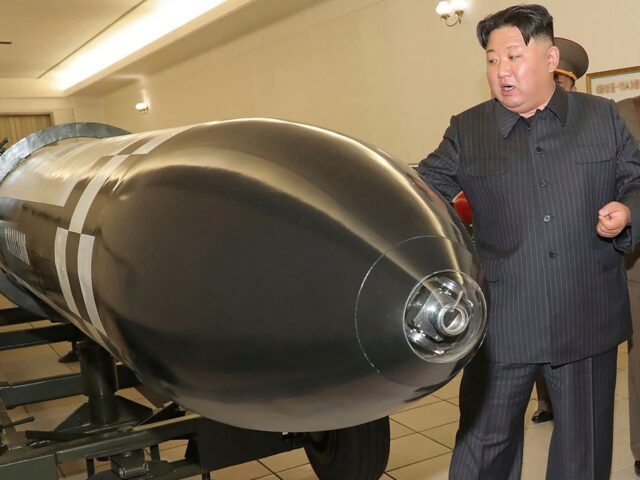North Korea’s state media outlets published photos on Tuesday of communist dictator Kim Jong-un alongside a weapon identified as the “Hwasan-31,” the country’s first apparent tactical nuclear warhead produced in response to Kim’s call for the country to become “flawlessly prepared to use nuclear weapons anytime and anywhere.”
The Korean Central News Agency (KCNA), the flagship state media apparatus is North Korea, also claimed on Tuesday that the nation’s Academy of Defense Science once again tested an “underwater nuclear attack drone” throughout the weekend.
The alleged novel weapons debut follows Kim’s public call in late December, during a communist Workers’ Party meeting to discuss plans for the incoming year, for North Korea to “exponentially” increase its nuclear weapons arsenal and his proclamation in September outlawing denuclearization. Kim’s elevated threats, directed primarily at South Korea and America, have resulted in an increase in support for nuclear weapons development in South Korea, where multiple polls show upwards of 70 percent of people support obtaining nuclear bombs.
The U.S. government under left-wing President Joe Biden has done little since his inauguration in 2021 to address the growing North Korean threat, or tensions between the two Koreas generally. Biden visited Seoul in May, meeting with then-newly inaugurated conservative South Korean President Yoon Suk-yeol, but North Korea did not react publicly to the visit, nor did it appear to affect the situation.
North Korea’s ramped up coverage of its nuclear weapons development this week appears to be a direct response to planned American and South Korean military exercises. The USS Nimitz, an aircraft carrier, and a carrier strike group arrived in South Korea’s southern port city of Busan on Tuesday to participate in scheduled drills.
In its reporting on Tuesday, KCNA claimed that Kim Jong-un personally “guided the work for mounting nuclear warheads on ballistic missiles” on Monday.

A woman walks past a television showing a news broadcast with file footage of missiles during a North Korean military parade, at a railway station in Seoul on March 27, 2023.North Korea fired two short-range ballistic missiles on March 27, South Korea’s military said, the latest in its flurry of weapons tests in recent weeks. (ANTHONY WALLACE/AFP via Getty Images)
“He acquainted in detail himself with the means for applying nuclear weapons, technological specifications and features of structural operation of new tactical nuclear weapons according to the purpose of the operation and targets,” the state outlet alleged, interchangeability with different weapons systems, etc.”
The South Korean news agency Yonhap reported that, along with the article announcing the new weapons development, KCNA released photos of smaller warheads identified as the “Hwasan-31,” a weapon not yet seen in North Korean media.
“Photos showed around 10 tactical nuclear warheads lining up, with an apparent intent to show that the country could put such warheads on super-large multiple rocket launchers or cruise missiles targeting South Korea,” Yonhap reported.
KCNA quoted Kim as making bizarrely conciliatory statements, such as alleging that North Korea’s nuclear weapons development was not meant to be a threat to “any state or specific group but war and nuclear disaster themselves.” The display of a growing number of weapons in North Korea’s nuclear arsenal, he allegedly stated, was meant to prevent a nuclear war.
“[H]e said that when we are flawlessly prepared to use nuclear weapons anytime and anywhere, nuclear weapons would not be used forever,” KCNA claimed, “and if the powerful and superior nuclear force going beyond imagination is ready for offensive posture, the enemy would fear us and not dare provoke our state sovereignty, system and people.”
Kim nonetheless ordered his underlings to “expand on a far-sighted way the production of weapon-grade nuclear materials.”
Separately, North Korean scientists allegedly tested an “underwater attack drone” last week, according to KCNA. The drone, called the “Haeil-1,” allegedly cruised “along a jagged and oval course simulating the distance of the 600 kilometers in the East Sea of Korea for 41 hours and 27 minutes and correctly set off the test warhead underwater.” North Korea’s government media similarly reported last week that it was developing an underwater drone capable of causing a “radioactive tsunami,” a weapon apparently directed at South Korea.
“This nuclear underwater attack drone can be deployed at any coast and port or towed by a surface ship for operation,” KCNA said at the time.

This photo provided on Tuesday, March 28, 2023, by the North Korean government shows a missile launch test on March 27, 2023, in undisclosed location, North Korea. (Korean Central News Agency/Korea News Service via AP)
North Korea’s elevated publicity for its development of a variety of nuclear materials coincides with the arrival of the Nimitz in Busan. Apparently outraging Pyongyang further than traditional joint exercises, the war games planned in South Korea next week will also include the participation of Japan’s Self-Defense Forces (SDF). Rear Adm. Christopher Sweeney, the commander of Carrier Strike Group 11, told reporters in Busan that the purpose of the exercises was to ensure proper “interoperability” among the three friendly forces (Japan formally does not have a military). Sweeney emphasized that American forces are “not threatened or worried about North Korea.”
North Korea made clear in a commentary published by the state newspaper Rodong Sinmun on Tuesday that it is threatened and worried about the United States – and that Kim’s events featuring new weapons were intended to intimidate the enemy forces.
“The U.S. ever-escalating war hysteria and moves to stifle the DPRK [North Korea] in March are inching close to an intolerable grave phase,” the newspaper asserted. “The DPRK has already warned that the U.S. reckless military provocations and war drills against the DPRK will drive the situation on the Korean peninsula to the critical point of outbreak of a nuclear war.”
Rodong Sinmun took particular offense to a joint American-South Korean drill known as “Freedom Shield,” which it claimed included exercises practicing the occupation of Pyongyang and “beheading” the communist government.
“All these military exercises of the enemy for demonstration clearly show that they are military actions for a preemptive attack which can not be looked on with folded arms any longer as they are waged after making a war of aggression against the DPRK a fait accompli,” the state outlet declared, calling the drills “an open declaration of war.”
“It is quite natural for the nuclear force of the DPRK to fulfill its important mission to cope with the grave situation in which the sovereignty and security of the state are threatened,” Rodong Sinmun concluded.
Follow Frances Martel on Facebook and Twitter.

COMMENTS
Please let us know if you're having issues with commenting.